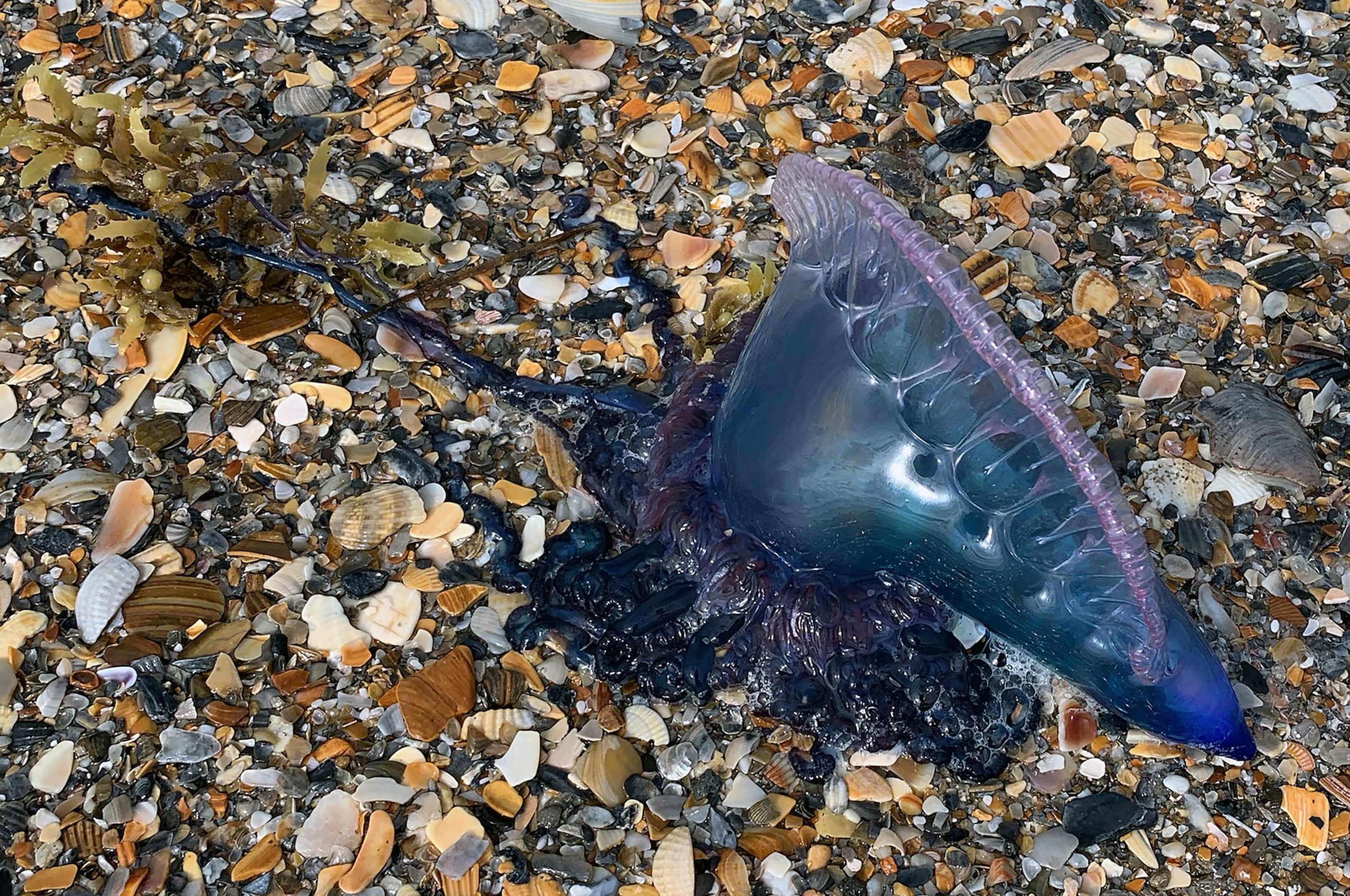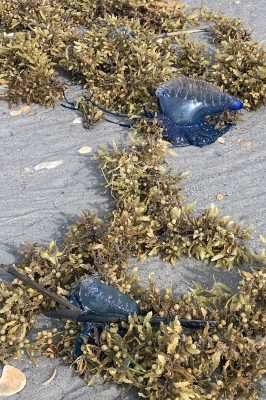
The Portuguese man-of-war, a blue-crested float attached to a dark mass of tentacles, has been spotted in large numbers on beaches during the past several weeks at Fort Macon State Park, Cape Lookout National Seashore, Wrightsville Beach and elsewhere along the North Carolina coast.
Found in the Atlantic, Pacific, where they’re called “blue bottle,” and Indian oceans, men-of-war are not jellyfish, but are a colonial group of animals that function as one creature. Starting in the early spring every year, the men-of-war are carried up the coast from the Caribbean by prevailing Gulf Stream currents and winds that move them along in the ocean before being stranded on the sand the tide.
Supporter Spotlight
Karen Duggan, interpretive park ranger with Cape Lookout National Seashore, said that how many men-of-war they see during a season depends on the storm tracks and the winds and waves or swells they generate.

Cape Lookout in Carteret County is made up of 56 miles of remote beaches that can only be reached by a boat of some sort.
“We can go without any all season or we may get several episodes. The number coming ashore will vary and it is often really hard to estimate as we have 4 individual islands – two are about 20 miles in length, one is about 9 miles in length and the last is only a mile or two,” said Duggan. When you are dealing with a developed beach, such as in a town, and only maybe a couple of miles in length, it’s a lot easier to get there and estimate the numbers.
The seashore posted on May 2 the first Portuguese man-o-war of the season had been observed and photographed, showing a tendril, or group of tentacles training in the sand, with a capability to sting anyone who stepped on it.
“We had more Portuguese man-of-war washing in on the soundside beaches behind the island of Shackleford Banks on May 31st. Currents have carried them through Beaufort Inlet and onto the beaches of the western end of the island,” said Duggan.
Supporter Spotlight
Duggan said the National Park Service believed the men-of-war came ashore with the help of a south and east wind associated with weather fronts moving through the region.
Duggan said that men-o-war have tentacles that average 30 feet in length, with a maximum tentacle length of about 50 feet.
The tentacles are covered in venom-filled stinging cells, called nematocysts that the animal uses to paralyze and kill fish, and other small creatures that swim into their dangling net of tentacles.
For humans, a man-of-war sting is very painful, but rarely deadly. But beware, even dead men-of-wars that have been washed up on the beach can still deliver a powerful sting.
“The float is what we notice the most when they’re on the beach. Often the tentacles are buried in the sand but they are still a danger to bare feet and pets. If you step on them, you’ll know it — They hurt. Give any floats that you see a wide berth, so you don’t encounter the tentacles,” Duggan said.

If you see the blue bubble of a man-o-war on the beach keep your kids away, and bury the tentacles by using a credit card, or other creative barrier you may have with you on the beach, Duggan suggested.
“Anyone who encounters the animals should be cautious and avoid contact,” she said. “The tentacles release thousands of microscopic venom-injections onto the skin and can lead to death on rare occasions, especially if stung around the face, and neck area while swimming.”
North Carolina Aquarium Education Curator Dia Hitt explained that the Portuguese man-of-war is a colony of zooids, or small animals, that work together for survival. Together they are known as a siphonophore.
“They are not considered jellyfish since they are not one animal but many. They don’t have a propulsion system; instead, they are at the mercy of the wind and the currents. Which is why some years we see them and other seasons we don’t,” Hitt said. “As far as I know, there is no count available to determine how many show up each year. Some years we see lots of them and other years we hardly see any.”
Their polyps help them with feeding, defense and reproduction. The large air bladder on top is a type of polyp and is filled with gases. It helps keep the animal afloat.
“They are invertebrates which means they have no backbone. They are also carnivores eating plankton and other small animals,” Hitt added. “Jellyfish and other planktonic animals are a very important part of the food chain. Sea turtles, marine mammals, fish and other animals all depend on these animals. In fact, jellyfish is one of the favorite foods for leatherback sea turtles, and Giant Ocean sunfish.”
Hitt said the tentacles have venom-filled structures called nematocysts on them that they use to capture prey. “Unfortunately, these structures can also cause a powerful sting in people.”
If you get stung, the best course of action is to rinse that part of your skin with vinegar to get rid of anything the animal may have left behind, according to a 2017 news release from the University of Hawaii at Manoa. Then, researchers recommend putting that part of the skin in hot water or covering it with a warm object.
“I recommend that visitors carry a small bottle of vinegar with them so if they, their children or their pet are stung they can treat the affected foot, paw, or hand immediately. If swimming and stung in the face, or neck area, seek medical help as soon as is possible,” Duggan said.
“A second treatment involves using Adolph’s Meat Tenderizer, the plain version without any other spices added, and is the brand of choice as it uses papain, which counteracts the effects of the poison injected by the jellyfish. Mix some of the meat tenderizer powder with water to make a muddy compact, and place it over the affected area. There may be other brands available, but Adolph’s is basically your choice, especially here in the Southeast,” Duggan added.







